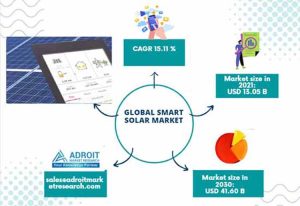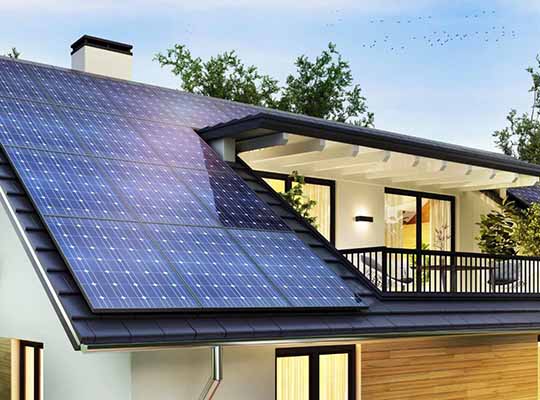According to Adroit Market Research, the global smart solar market was valued at USD 13.05 billion in 2021 and by 2030, this market is expected to have grown to USD 41.60 billion, with a CAGR of 15.11%.
The term “Smart Solar” describes the incorporation of cutting-edge technology and clever solutions into solar energy systems in order to increase their effectiveness, connectivity, and responsiveness. The idea is on utilising cutting-edge technology to optimize solar energy’s whole lifespan, from production to consumption, and to make it easier to integrate it into a larger energy ecosystem.
Sensors, meters, and monitoring tools are included in smart solar systems, which enable them to gather data on energy usage, environmental conditions, and solar energy output over time. Consumers are becoming more and more concerned with their health and want to maintain the nutritional value of their food. IoT technology is essential to Smart Solar since it allows for data interchange by linking multiple solar system components to the internet. Real-time monitoring, remote management, and automation are made possible by this link. Artificial intelligence and sophisticated data analytics are used to process the data gathered by Smart Solar systems. Artificial intelligence (AI) algorithms can analyze the data to find trends, maximize energy output, anticipate maintenance requirements, and come to wise conclusions about energy storage and distribution.
Governments, companies, and consumers all over the globe are increasingly turning to renewable energy sources like solar power to satisfy their energy demands as a result of growing worries about climate change and the need to cut greenhouse gas emissions. By increasing the overall effectiveness and dependability of solar energy systems, smart solar technologies can increase their appeal for adoption. Batteries and other energy storage technologies have significantly improved and become more affordable, making it simpler to store extra solar energy for use when there is little or no sunshine. Better load balancing and energy management are made possible by integrating smart energy storage with solar power systems, which promotes the use of smart solar technology.

The growth of the Internet of Things (IoT) has made it easier to create systems and devices that are connected. IoT-enabled sensors and monitoring tools in the context of smart solar enable real-time data collecting and analysis, optimizing solar energy output and consumption. The requirement for efficient administration and coordination grows as more solar power installations are hooked up to the grid. Better demand-response mechanisms and overall grid stability are made possible by smart solar systems’ seamless interaction with smart grids. Many governments all around the globe are putting supportive measures and incentives into place to encourage the use of renewable energy sources, including solar energy. Tax incentives, feed-in tariffs, and regulatory measures that promote the integration of smart technology are frequently included in these programmes.
Solar energy is becoming more competitive with traditional fossil fuels because of a steady decline in the price of solar PV panels and related technologies over time. Additionally, continued technical advancements in the field of smart solar have increased system effectiveness and decreased operating expenses. Consumers and companies are increasingly looking for cleaner energy alternatives as environmental awareness rises. Smart solar technologies, which provide a cleaner, more sustainable energy choice, support these goals.
Real-time monitoring and optimization of solar energy output and use are made possible by smart solar systems. Businesses and households may spot trends in energy usage, optimize energy output, and lower waste by utilizing data analytics and IoT-enabled devices. Over time, this results in greater energy efficiency and cost savings. Integrating solar systems with the current grid is essential as the proportion of solar energy in the energy mix rises. By delivering real-time data on solar energy production and consumption, smart solar systems promote smooth grid connection and aid in grid stabilization. The total energy infrastructure’s stability and resilience are improved by this integration. Batteries and smart solar technology can be used together to store extra solar energy for usage during times of poor solar irradiation. Energy storage solves the intermittent nature of solar energy and guarantees a more reliable energy supply, especially at night or in cloudy weather.
Due to the growing number of smart solar projects taking place in the region, North America is projected to see considerable development throughout the course of the study’s timeline. Additionally, the accelerating implementation of smart solar meters and the rising grants and solar subsidies from the US government are projected to support the expansion of the regional industry. Governments in North America have concentrated on enacting laws and incentives to promote the use of solar energy, such as grants, subsidies, and tax credits. The region is home to a number of top solar enterprises as well as research and development centres devoted to developing solar technology, which eventually supports the expansion of the local market.









